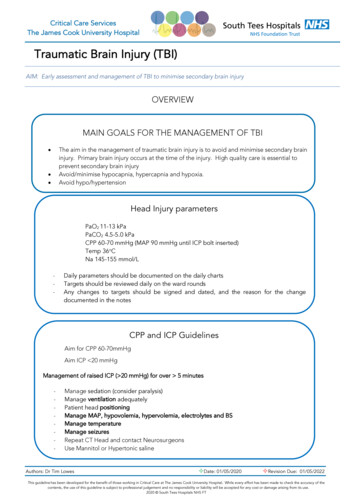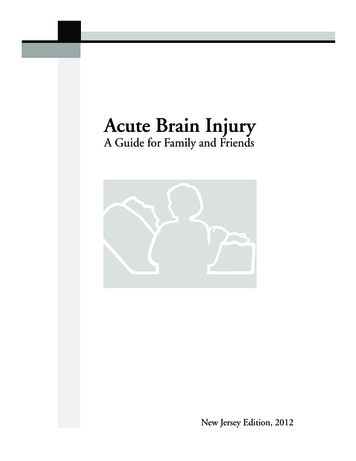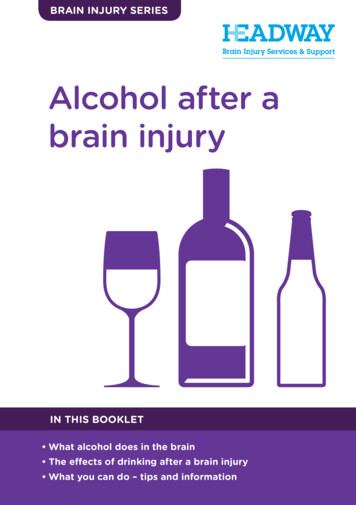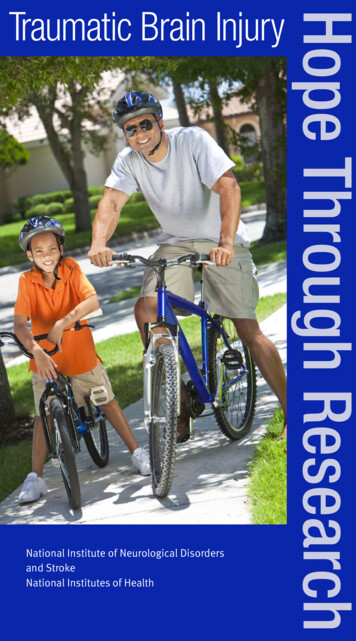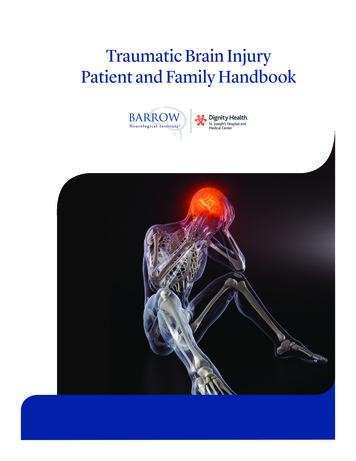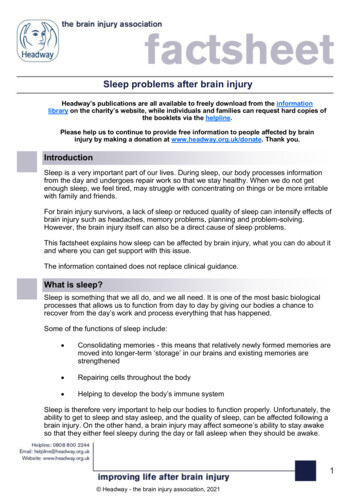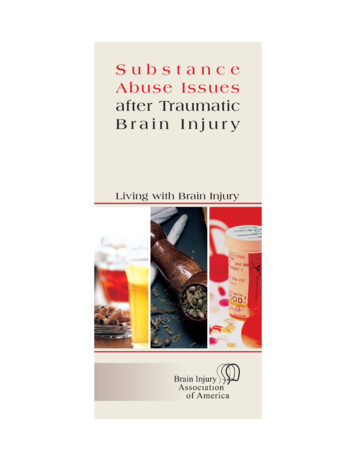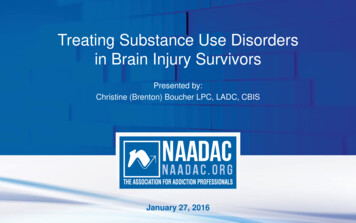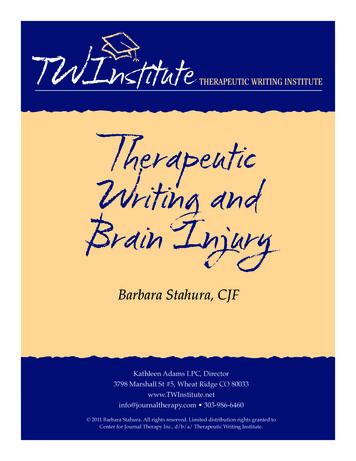
Transcription
TherapeuticWriting andBrain InjuryBarbara Stahura, CJFKathleen Adams LPC, Director3798 Marshall St #5, Wheat Ridge CO 80033www.TWInstitute.netinfo@journaltherapy.com 303-986-6460 2011 Barbara Stahura. All rights reserved. Limited distribution rights granted toCenter for Journal Therapy Inc., d/b/a/ Therapeutic Writing Institute.
Therapeutic Writing and Brain InjuryBarbara Stahura, CJFSubmitted to the Therapeutic Writing Institute as the capstone projectfor the credential of Certified Journal FacilitatorAn injury to the magnificent, mysterious brain can upset the familiar story of a lifein ways no other injury or illness can. People with brain injury may face challengeswith physical abilities and, more essentially, with confounding changes to their mentaland emotional abilities. So much that they knew about themselves — the wealth ofinformation they depended on to lead their lives — can blur or disappear, leaving themstranded and struggling in an unknown place. They face the challenges of making senseof a life disrupted and perhaps altered forever; of being accepted — sometimes even bythemselves — as a person who still has value andwhose life still holds meaning and purpose; and ofHow can one createrevealing a new self to people, perhaps even theirloved ones, who don’t understand or realize theand live a satisfyingchanges the brain trauma has caused.After surviving a brain injury and undergoingwhatever usual therapies are prescribed to restoreas much function as possible (or as long as one’smoney or insurance holds out), survivors face a dilemma not touched upon in physical,occupational, or speech/cognitive therapy: restoring or rebuilding the intricate, intimatestory of one’s life when that story has been altered, perhaps even severely, by damage tothe brain. When a brain injury destroys or denies access to large parts of the familiar storyof one’s life, how can one create and live a satisfying “new normal”?The answer: By looking deep inside at the heart and spirit — the place wherecreation takes place — and expressing on the page what one finds there.“new normal”?My StoryUntil December 29, 2003, I had little interest in or knowledge of brain injury. But on thatday, a still-unidentified white sedan turned left in front of my husband as he rode hismotorcycle on a busy Tucson street. Having the right-of-way, yet unable to avoid the
collision, Ken smashed into the car head-first and then landed on the pavement, whichsent his brain careening against the rough-edged walls of his skull. Only his high-qualityhelmet saved his life. Thrust into the role of caregiver, I could not help but follow him onthis fearful, confusing journey. Two things became necessary: that I learn all that I couldabout his brain injury in order to care for him, and that I find a way to also care for myself.Like many caregivers, I had more success with the former than the latter.One of the best things I did for both of us was to journal. Already a long-time journalkeeper at that time, I filled pages nearly every day during Ken’s stays in two hospitals,during his in-patient rehabilitation, and then as he struggled through outpatient rehab forseveral more months. My journal was my confidante and my sanctuary. Journaling wasmy release and the one always-dependable source of solace available to me. I believe itpreserved my well-being, particularly after a counselorsuggested I was suffering from secondary traumaticstress. Also called compassion fatigue, this condition iscommon among family caregivers of people with braininjury. Symptoms include anxiety, exhaustion, sleeplessness, depression, decreased feelings of pleasure, and areduced ability to feel compassion.I did for both of usMonths later, my journal became a sort ofwas to journal.memory-in-writing for Ken, when I suggested he readit to learn about our story of the weeks and months ofwhich he had retained little to no memory.Several years later, an idea came to me that would change our lives, although Ididn’t realize it at the time: If journaling had been so helpful to me as Ken’s caregiver— who had been confused, frightened, and angered by this alarming alteration of his life,my life, and our life together — perhaps it would also be helpful to those who were livingwith brain injury. I already knew about some of the studies of what Dr. James PennebakerOne of thebest thingscalled “expressive writing,” which showed resulting benefits for many groups of peopleas they wrote for brief periods about traumatic experiences. A research psychologist atthe University of Texas at Austin, Pennebaker began his research in the mid-1980s, whichlaid the foundation for the new field of therapeutic writing. Many other researchers havefollowed his lead since then. In addition, I knew from my own experience how journalinghad offered me a safe footing from which I could grope for clarity in the midst of blindingfright and confusion. It was the place to explore my thoughts and feelings in a way thatsimply ruminating about them could not do.So, I thought, why couldn’t this kind of writing benefit people with traumaticbrain injury (TBI) and other brain traumas? And why couldn’t I be the one to create ajournaling experience just for them?
I hesitated at first, having no background in designing a journaling curriculum orin facilitating a group. I was not a therapist, nor did I have any other “official” credentials.What qualifications did I have?These: I had journaled on and off since the early 1990s and had read numerousjournaling books, working many of the suggested exercises. In addition, my successfulwriting career of nearly twenty years had taught me how to research a topic and writecompellingly and accurately. I had already written about TBI: two articles about braininjury among military personnel as a horrific result of the war in Iraq for a Veterans Administration publication, and several personal essays about our experience, one of whichwas published on Newsweek.com. And, importantly, I trusted my intuition and myheartfelt desire to help Ken and others with brain injury to better understand themselvesand their new lives.Furthermore, I had the expertise of Susan B. Schuster, MA, CCC-SLP, Ken’s formeroutpatient speech/cognitive therapist, to call upon for the more technical issues relatingto brain injury. Susan is employed at HealthSouth Rehabilitation Hospital of SouthernArizona, in Tucson, and in late 2007 she introduced me to CEO Martha Gerganoff, forwhom I wrote a proposal for a six-week trial workshop titled “After Brain Injury: TellingYour Story.” Martha believed the proposal was a good one and that hosting the workshopthere would be a valuable community service,one not offered elsewhere in Tucson.With five of Susan’s past or currentpatients, including Ken, participating, Ifacilitated the first session of After Brainto have a safe place whereInjury: Telling Your Story. Each week forthey would be respected.six weeks I created a new outline for thenext session, which enabled me to tailor thesessions as the weeks passed. I learned as we went along, and the group members participated with enthusiasm, even though they had not journaled before. They received handouts with information about story and journaling, as well as prompts, which they kept inthe three-ring binders that HealthSouth had purchased for use as journals. Susan acted asa quiet co-facilitator, mostly sitting in the back and being present should problems arisewith participants. In four years and nine groups, only one minor problem occurred.The trial workshop was a success. The participants appreciated the opportunityto write about themselves and their experiences, and to share what they had written.They were happy to have a safe place where they would be respected and meet withother people with brain injuries, who understood them as no one else did. I learned thatI could facilitate a journaling group. Martha gave us permission to keep the group going,and we settled on offering it twice a year, in the spring and the fall. After the first group,They were happy
HealthSouth paid a fee to me so that group members could attend for free, since financescan be problematic for people with brain injury.The ninth and last Tucson group was held in June of 2011. The program endedonly because Ken (who had attended all nine groups) and I were moving to Indiana,where I hoped to start up another such group.In between the first group in 2007 and the last in 2011, my confidence as a facilitatorgrew and my life changed. The members of these groups had inspired me with their courageand honesty. They also expressed many timeshow helpful the group process with journaling,and I as facilitator, had been as they traveled theThe group membersroad of whatever recovery was available to them.inspired me with theirI decided to continue learning how to becomea more effective journaling facilitator. In thesummer of 2009, I became a certified instructorof the Journal to the Self workshop throughthe Center for Journal Therapy, and that fallbegan coursework to become a Certified JournalFacilitator through the Center’s professional training division, the Therapeutic WritingInstitute. In 2010, I gave up my freelance writing career to devote myself full-time tojournaling work.In the summer of 2009, my book After Brain Injury: Telling Your Story was publishedby Lash & Associates Training/Publishing (http://www.lapublishing.com/tbi-survivorjournal). Co-authored with Susan Schuster, this expanded version of the workshop wasthe first journaling book for people with brain injury. Among its endorsements are thosefrom James Pennebaker and Kathleen Adams.courage andhonesty.Brain InjuryI originally designed After Brain Injury: Telling Your Story for people with TBI, since thatwas the brain trauma with which I was most familiar due to Ken’s accident. Yet in onesense, a brain injury is a brain injury: Regardless of the cause, many of the resultingdysfunctions are the same. So people with other kinds of brain trauma, considered to beacquired brain injury (ABI), joined the groups over the years.TBI. The Veterans Administration defines TBI as “the result of a severe or moderateforce to the head, where physical portions of the brain are damaged and functioningis impaired.” In 2011, the Brain Injury Association of America (BIA) began using thisdefinition: “An alteration in brain function, or other evidence of brain pathology, caused
by an external force.” Each year, 1.7 million Americans sustain a TBI — more than thetotal of those diagnosed with breast cancer, HIV/AIDS, multiple sclerosis, and spinalcord injuries. Five million Americans live with permanent disability as a result of a TBI,and it is a contributing factor to one-third of all injury-related deaths in the U.S.Anyone with a brain is susceptible to a brain injury. The four major causes of TBI,in order of incidence, are falls, motor vehicle-traffic, “struck by/against” events (collidingwith an object), and assault. A TBI can result either from a closed-head injury or onewhere an object penetrates the skull. TBI can range from mild (a brief change in mentalstatus or consciousness) to severe (an extended period of unconsciousness or amnesiaafter the injury). Ken’s TBI was a closed-head injury in the moderate to severe range.Yet even the so-called “mild” TBI (mTBI) can have devastating effects on a person, particularly if the injury is not allowed to heal properly. People with mTBI may not realize itright away nor realize the seriousness of this injury, so they continue with the behavior— playing football, for instance — that puts them in a position to either not recover wellor to sustain more damage to their brains. Sadly, only recently has mTBI been realized tobe a serious condition.Many mTBIs were often passed offas nothing to worry about: “You just hadyour bell rung. It’s only a concussion. You’llis susceptiblebe fine.” But a concussion is a brain injury,and must be regarded as such. With rest andto a brain injury.proper care, most people with mTBI recoverfully. A good recovery, however, first requiresa proper diagnosis, which can be difficult in these cases. Sometimes symptoms—memoryproblems, personality changes, cognition deficits, and more—do not appear until weekslater, making the connection difficult. And statistics show that once a person has a TBI, heor she has a greater chance of having a second one. A proper diagnosis after the first oneis crucial.Unfortunately, the effects of multiple brain injuries, no matter how “mild,” are notmerely cumulatively worse; the effects grow exponentially. Multiple mTBIs can lead tothe horrendous effects now being discovered in young, retired NFL players, such as theinability to function, severe depression, early dementia, and even death.In a bittersweet synchronicity, I was developing my program as the nation’sinterest in TBI was growing. The news was filled with the rising numbers of militarypersonnel returning from Iraq and Afghanistan with TBIs, some quite horrific, becauseof the extensive use of improvised explosive devices, or IEDs. Around 2005, moderateto severe TBI was coming to be known as the “signature wound” of these wars. Somewere caused by bullets and other projectiles penetrating the brain, while thousands ofAnyone with a brain
more subtle injuries were caused by exposure to a blast. Even with no visible wound,the fragile, jelly-like brain of a human being exposed to a bomb blast is damaged by themassive pressure wave that sweeps from the blast and then rapidly surges back to fillthe vacuum. (Recall that some of these blasts have flipped vehicles weighing 25 tons ormore.)Prior to 2007, I had written several articles on this subject, and what I learnedfueled my desire to create my program. By 2011, it was estimated that more than 400,000service members had sustained some level of TBI during their deployments. Most ofthese have been mTBIs, but, tragically, the U.S. military’s admission of the prevalence andseriousness of mTBI took far too long. Treatmentand care are still poor and often nonexistent.After a brain injury,Furthermore, with exposure to multiple blasts, asis common, especially in additional deployments,the familiar storythe danger of permanent disability grows.of a life undergoesmajor shifts.ABI. There is another classification of braininjury called acquired brain injury; it resultsfrom a non-traumatic cause. The BIA definition:“An injury to the brain, which is not hereditary, congenital, degenerative, or induced bybirth trauma (It) is one that has occurred after birth.” These result from strokes, neardrownings, hypoxic or anoxic brain injuries (too much or not enough oxygen to the brain),tumors, neurotoxins, electric shocks, or lightning strikes. Another 795,000 Americanssuffer an acquired brain injury every year. More than 125,000 members of this group livewith ABI-induced permanent disability.Story as MedicineAfter a brain injury, the familiar story of a life undergoes major shifts. Sometimes it evencrumbles. The focus becomes moving forward within a “new normal” — a new story.Whatever its cause, each brain injury is as unique as the person to whom it happens.While a brain injury can affect physical function, which is difficult enough, it is uniqueamong injuries that can befall humans in that it can disrupt the most fundamental aspectsof what makes us “us” — personality, memory, thought processes, emotions, motivation,self-control, the ability to learn and concentrate, self-expression, and more. Any one ofthese changes — let alone several — can cause confusion, stress, and worse to the injuredand their families. As I wrote in “How My Husband Came Back” for Newsweek.com,“The white sedan that turned in front of my husband on his motorcycle might as wellhave been a rocket blasting us to an alien planet against our will. Left with a traumatic
brain injury, the Ken I loved, the Ken defined by his unique neural pathways—as we allare—threatened to vanish into the darkness that had sucker-punched his brain.”After such a trauma, it’s important that survivors spend time in a process of selfdiscovery to figure out how to live as their new selves: different—sometimes in significantways—from their former selves.Typical brain-injury rehabilitation includes physical, occupational, and speech/cognitive therapy. All are invaluable for recovering as much as possible and for improvingpost-injury life. Unfortunately, once people with brain injury are discharged from therapyor rehab (which, sadly, can fall woefully short of the optimal amount, due to financial,insurance, and availability issues), they often have few options for learning how tounderstand and handle all the changes to which they have been subjected. They and theirfamilies frequently have little or no guidance in how to re-create the story of their lives asthey adjust to their new normal, which can leave them all adrift at a particularly tenderand frightening time.Even though we humans build our lives around story, traditional brain-injurytherapies do not address this issue, and appropriately so. They are meant to restorefunction or offer adaptations in the face of disability. Yet as Christina Baldwin writesin Storycatcher: Making Sense of OurLives Through the Power and Practice ofWe haven’t explored theStory, “Story is the narrative thread ofpower of journal writing toour experience — not what literallyhappens, but what we make out of whathappens, what we tell each other andwhat we remember.” Making meaningout of living with a brain injury is not an easy task, and it is something only the affectedperson can do. If you are not who you used to be, who will or can you be now? Tellingyour story can help you discover the answer and lay the groundwork for reaching a morepositive future.Another concept that played a large role in the creation of After Brain Injury:Telling Your Story came from Deena Metzger’s Entering the Ghost River:anticipate a change.“’What is your medicine?’ I was asked.“’Story. Story is my medicine,’ I answered.”So I structured the program around the concept of story—what it is, why it’simportant to know and tell our stories, the methods of doing so—and how to use it toheal. Storycatcher was an important resource and inspiration. One quote from it encapsulated the essence of what I wanted my program to do: “Something is happening inthe power and practice of story: In the midst of overwhelming noise and distraction, the
voice of story is calling us to remember our true selves.” A brain injury can certainly besaid to create “overwhelming noise and distraction,” in the midst of which the true selfcan be lost.I’m not a therapist, nor an expert in any experience of brain injury other than minewith Ken. When I began writing the program sessions, I was admittedly groping in thedark. My aims were vague at first; all I had to go on was my strong belief that therapeuticwriting would benefit people with brain injury in some way—that it could be medicine—as it has been shown to be for many other groups since Pennebaker began his research inthe mid-1980s. But as my knowledge grew over several years, the program as expressedin the book After Brain Injury: Telling Your Story coalesced around these points: Creating a new story based on current realities allows us some measure of healing andoffers hope. Giving voice to emotions after a traumatic event such as a brain injury opens a path tonew self-understanding and to rebuilding our lives.Story is key to the process of living a rich, satisfying, post-injury life that makessense and has meaning. My basic goal for After Brain Injury: Telling Your Story was, andis, to provide simple writing exercises that engage people in exploring the post-injurystory of their lives with honesty, creativity,and imagination. After four years and ninegroups, I have seen that the program doeswhat I hoped it would. Self-exploration on theon the page is the waypage is the way to self-empowerment: This isto self-empowerment.the essence of therapeutic writing.Self-explorationThe Program and the PeopleIn putting together After Brain Injury: Telling Your Story, I did my best to create an engagingjournaling program. Yet there was one big difference from designing a workshop for otheraudiences: Due to their brain injuries, many of the participants had various limitationsthat might need to be accommodated. Here is a partial list of those limitations: Living with a brain injury, especially early on, can be exhausting. A healing brainsteals a great deal of energy from the rest of the body, which means the sessions can’tbe too long. I chose 90 minutes, which worked well. Participants might not be able to focus well for any length of time, so shorter writingtimes might be called for. In these groups, writing times were 5, 7 or 10 minutes,depending on the complexity of the prompt and process. Some participants might not be able to speak clearly. Some might have trouble with the physical act of writing, or finding the right words.
Some might be hyperverbal and need gentle reminders to stop talking. Others with certain memory problems might repeat themselves frequently. Emotional outbursts due to disinhibition resulting from the injury can occur, whilesome participants might not be able to express much emotion at all, nor recognize theemotions of others. For those not able to drive, transportation is problematic. This could impact ability toattend as often as affected ones would like.In one of my groups, a man who had suffered a severe TBI would enter the mazelike facility and then get lost. If he had not appeared in our room close to the start time,I learned to send someone out to look for him. He was usually waiting patiently in thecafeteria, knowing that we wouldn’t forget him.Susan Schuster suggested a screening process for participants to be sure theycould participate; this was established primarily for potential participants who had notbeen her patients. We created a basic form meantto determine whether the person could write byLike any good journalinghand (although we allowed laptops as well) andif he or she could follow simple instructions.program, this one had toBecause we met in a small conferenceroom where it would have been disruptive tohave someone talking while the others wrote,particularly for those participants who couldnot handle distractions or too much stimulation,Susan and I chose to require that people be able to write or use a laptop. However, as anaccommodation in the right circumstances, people unable to write could use a recordingdevice and speak their journal entries, or a trusted person could act as a scribe for them.(These activities can work equally well for people journaling by themselves or with atherapist, rather than with a group.)Like any good journaling program, this one had to hold the interest of members,allowing them to participate in ways that felt safe yet creative, and also encourage themto extend themselves into areas they might not have explored before. Since I assumed thatmost of the people using this program would be inexperienced journalers, a section of theprogram explains that journaling is a proven therapeutic tool whereby one may discoverone’s inner self by expressing emotions, confronting fears, relieving anxiety, coping withstress, and preparing for new challenges. Participants also receive basic information onhow to journal.In its current form, After Brain Injury: Telling Your Story follows a generalizedprogression through a brain injury, from the cause of the injury to stepping out into theworld again. (However, even people as far as twenty years out from their injury havehold the interestof members.10
found it valuable.) Along the way, it allows users of the program to explore: changing sense of self loss of memory and resilience altered relationships with family and friends anger and emotions grief and loss acknowledgement, acceptance, and accommodation facing the future building hope moving forward positive elements of post-injury lifeThis exploration is done through various journaling techniques and exercises, mostof which rely on a “prompt” to focus the writing on a specific topic, although participantsare always free to write about another subject. Most of the writes are freewrites, in whichno specific journaling technique is used. The program teaches and uses the Dialogue andUnsent Letter techniques for several of the exercises.In addition to self-exploration, it became clear over time that the program alsooffers some practical, rehabilitative benefits: Enhances written and verbal communication skills Stimulates cognitive and executive skills (following direction, organizing, planning,sequencing, attention, processing, etc.) Promotes post-injury self-awareness (deficits and strengths) Assists in planning for the post-injury future Promotes dialogue and understanding with family members and others Encourages self-expression after a trauma and major life disruption Prepares for community re-entry Offers community and support when done in a facilitated group.In the nine groups, many of the participants were men with TBI resulting frommotor-vehicle incidents, generally motorcycle, with and without helmets. The braininjuries sustained by other men and women in the group resulted from assault, anoxia dueto a heart attack, aneurysm, bicycle accident, meningioma (non-malignant brain tumor),brain surgery, falls, stroke, attempted suicide, and a sinus surgery gone horribly wrong.Despite the difference in causes and age ranges (16 to 65), each group of participantsformed a new, temporary community based on their one similarity: having sustained abrain injury that changed their lives.One interesting development: Even for those members who participated in all ormost of the groups and wrote on many of the same topics time after time, they wereable to find new ways to approach the subject, which gave them a variety of perspec11
tives. While I was concerned they would be bored, they seemed to relish the repetitionbecause it allowed them to see and measure their progress and change in perspective overtime. Sometimes the structure and content of the writing improved. This was especiallynoticeable for the members who participated in the group over several years. Sometimeswriting on the same topic several times but months apart provided a new view of anongoing challenge, which enabled the writer to explore necessary changes. Additionally,keeping their journals meant they had a record of the past, which they could compare tothe present. This was often a boost to morale during tough times when they believed theyhad not made much progress.While planning this program and during the years I facilitated the groups, I searchedfor studies addressing the affect of journaling on people who had sustained brain injuries,but was unable to find any. I assume that either none have been done, or none have beenpublished yet, although I believe it would be an excellent research subject. Even withoutsuch data, my personal experience as the facilitatorallows me to say that journaling after brain injury hasbeen beneficial for the group members. Furthermore,Many participantsthe experience of facilitating these groups has taughtwere surprised byme a great deal about the human spirit, brain injury,the insights thatand therapeutic writing.Most of the people who attended After BrainInjury: Telling Your Story groups had never journaledor done any form of written introspection before. Yetwith only one or two exceptions, they were eager towrite and share their stories. Even the few with theworst disabilities, who could barely scratch out a couple of sentences in a 7-10 minutespan, felt comfortable enough within the safe embrace of fellow survivors to write whatwas in their hearts. Many were surprised by the insights that flowed onto their pages. Itwas heartening to watch how those who attended the group more than once progressedin their recovery, accepted what had happened to them, and grew from their experiences,as demonstrated by their journal entries.As is common in most journaling groups, we used a two-part process in ours:writing and optional sharing. The writings, of course, were the basis for what followed.They often described, in profound and moving terms, the experience of living with braininjury in ways that no academic or medical text can match.Here are some examples, all of which can be found in After Brain Injury: TellingYour Story.The exercise “Writing a Letter” uses the Unsent Letter technique. While this letteris never meant to be sent, it can provide clarity, offer an opportunity to vent, or allow com-flowed ontotheir pages.12
munication with someone no longer in the life of the writer. In this particular exercise,people are asked to write a letter to their brains.In response, Michael, who was only about eighteen months out from a severeTBI, wrote:Hello, Mr. BrainPlease forgive me for not keeping you safe. I should of been wearing a helmet to keep youprotected. You need to know that I’m here to protect you and try to get you back in firstclass shape again. I will try to make good decisions that will keep us safe.In “Making Metaphor,” participants are asked to compose metaphors that can beused to explain what it’s like to live with a brain injury. Ken wrote:Before my brain injury, my memory was like a long shelf that could hold a lot. Now, it’smuch shorter, and memories fall off the back when I add new ones to the front.People with brain injuries are often treated differently than when they were“premorbid,” i.e., before their injury. They require the opportunity to explain what theyneed and how they would like to be treated. For “What I Really Need,” Elizabeth wrotethis plea:Sometimes people try to help me by guessing what I want or mean. What would reallyhelp me instead is for people to back off and
sense, a brain injury is a brain injury: Regardless of the cause, many of the resulting dysfunctions are the same. So people with other kinds of brain trauma, considered to be acquired brain injury (ABI), joined the groups over the years. TBI. The Veterans Administration defines TBI as "the result of a severe or moderate

